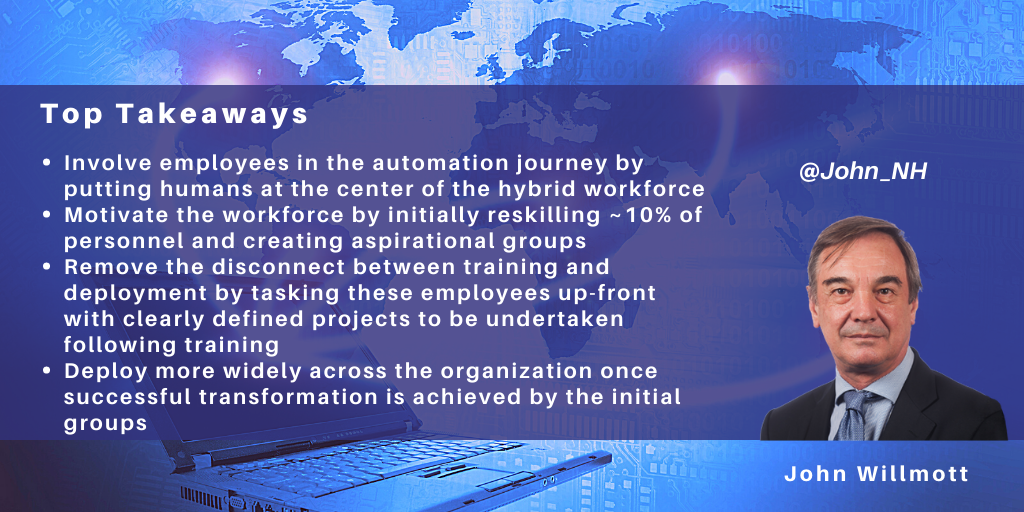Search posts by keywords:
Filter posts by author:
Related NEAT Reports
Other blog posts
posted on Feb 25, 2021 by John Willmott

This is Part 1 of a two-part blog looking at Capgemini’s Intelligent Process Automation practice. Here I examine Frictionless Enterprise, Capgemini’s framework for intelligent process automation that focuses on the adoption of a digitally augmented workforce.
Digital transformation has been high on enterprise agendas for some years. However, COVID-19 has given the drive to digital transformation even greater impetus as organizations have increasingly looked to reduce cost, implement frictionless processing, and decouple their increasingly unpredictable business volumes from the number of servicing personnel required.
For Capgemini, this has resulted in unprecedented increases in Intelligent Process Automation bookings and revenue in 2020.
Frictionless Enterprise & the hybrid workforce
There is always a danger in intelligent automation projects of regarding people as secondary considerations and addressing the workforce through reactive change management. As part of its Frictionless Enterprise approach, Capgemini's framework for intelligent process automation stresses the adoption of a digitally augmented workforce, and aims to avoid this pitfall by maintaining high workforce-centricity, stressing the need to involve employees in the automation journey by taking a structured approach to workforce communication and upskilling.
Capgemini's Intelligent Automation Practice emphasizes the workforce communication and reskilling needed to achieve a digitally augmented or hybrid workforce. This involves putting humans at the center of the hybrid workforce and motivating and reskilling them.
The personnel-related stages in the journey towards a Frictionless Enterprise that leverages a digitally augmented workforce used by Capgemini are:
- Design of the augmented workforce. On the design side, it is important to ask, "what is the impact of technology on the workforce and how should the organization's competency model change?" How is the workforce of the future defined?
- Building the augmented workforce
- Creating the right context.
Client cases
In one client example, Capgemini assisted a major capital markets firm in designing and building its digitally augmented workforce, using a four-step process:
- Resource profiling
- Dedicated curriculum creation
- Pilot on 15% of resources
- Augmented workforce scaling.
Step 1: Involved identifying personnel with a statistics or mathematics background who could be potential candidates for, say, ML data analysis. These potential candidates were then interviewed and tested to ensure their ability, for example, to run a Monte Carlo simulation.
Having established the desired job profiles, these personnel were allocated to various job families, such as automation business analysts, data analysts, power users, and developers, with developers split into low code/no-code developers and advanced developers.
Step 2: A dedicated curriculum was created in support of each of the job families. However, to ensure the training was focused and to increase employee engagement and retention, each employee was tasked up-front with clearly defined projects to be undertaken following training. This kept the training relevant and avoided a demotivating disconnect between training and deployment
Step3: 15% of the entire team were then trained and deployed in their new roles. This figure ranges between 5% and 15% depending on the client, but it is important to deploy on a sub-set of the workforce before rolling out more widely across the organization. This has the dual advantages of testing the deployment and creating an aspirational group that other employees wish to join
Step 4: Roll-out to the wider labor force. The speed of roll-out typically depends on the sector and company culture.
Capgemini has also helped a wealth management company enhance its ability to supply information from various sources to its traders by enhancing its capabilities in data management and automation. In particular, this required upskilling its workforce to address shortages of data, automation, and AI skillsets.
This involved a 3-year MDM Ops modernization program with dedicated workforce augmentation and upskilling for digitally displaced personnel, starting with three personnel groups.
This resulted in an average processing speed increase of 64% and an estimated data quality increase of 50%, and the approach was subsequently adopted more widely within the company's in-house operations.
AI Academy Practitioner's Program
Capgemini has created its AI Academy Practitioner's Program, an "industrialized approach" to AI training to support workforce upskilling. This program is mentor-led and customizable by sector and function to ensure that it supports the organization's current challenges.
The program's technical elements include:
- "Qualifying" (6 hours over 3 days) for personnel who only need to be aware of the potential of AI
- "Professional" (10-hours per week for 4 weeks), where personnel are provided with low code tools to start developing something
- "Expert" (10-hours per week for 4 weeks), incorporating custom AI & ML model building.
The program's functional courses include:
- Data literacy (4 hours over 4 days)
- Business functional (10-hours per week for 4 weeks)
- Business influencer (CXO) (15 hours over 3 days)
- Intelligent process automation (15 hours over 3 days), highlighting combining automation stack with AI.
Conclusion
In conclusion, the deployment of technology is arguably the easy part of intelligent process automation projects. A more challenging element has always been to motivate the workforce to come forward with ideas and enthusiastically adopt change. Capgemini's Frictionless Enterprise approach – that leverages a digitally augmented workforce – addresses this challenge by adopting an aspirational approach to upskilling the workforce and removing the disconnect between training and deployment.
